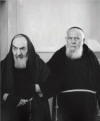 Padre Raffaele with Padre Pio
Padre Raffaele with Padre Pio
Radiance ecstasy levitation bilocation
Radiance
“As
Moses came down from Mount Sinai with the two tablets of the covenant the skin
of his face had become radiant.” Exodus, 34:29
Transfiguration: “His face shone like the sun and his clothes became white as
light.” Mt. 17:2
Baby Jesus
Padre Raffaele da Sant’Elia a Pianisi wrote that on August 19, 1919, he was
staying in the convent in a cell not far from the one of Padre Pio. It was very
hot and he couldn’t sleep. Around midnight he got up and was getting out of the
cell in the dark when he saw Padre Pio radiant in light, holding Baby Jesus. He
walked the hallway going towards his cell, passing by the cell of Padre
Raffaele. Padre Pio didn’t realize that Padre Raffaele was watching.[1]
[2]
[3]
Lucia Iadanza
The night of Christmas Eve December 24, 1992, Lucia Iadanza and 3 other women
had been preparing the altar for the Midnight Mass. When they finished they sat
around a brazier, waiting for the time of the celebration. While the other three
women were dozing, Lucia saw Padre Pio coming downstairs in the sacristy. He was
radiant in a brazing light, holding Baby Jesus in his arms. When Padre Pio went
close to the women around the brazier the vision had disappeared. Padre Pio then
saw Lucia looking at him in amazement. He said: “Lucia, what did you see?”
Lucia: “Padre, I saw everything.” Padre Pio: “Don’t tell anybody.”[4]
[5]
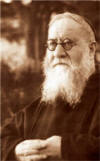 Padre Agostino da San Marco in Lamis
Padre Agostino da San Marco in Lamis
Nicola Pazienza
Padre Agostino Daniele reported in his diary on April 8, 1946 that: ”The farmer
Nicola Pazienza living not far from the convent, told me that one summer night
he saw from his yard Padre Pio’s room resplendent in a light brighter that the
sun, and Padre Pio was in this light. I checked that yard, and from there Padre
Pio’s window is clearly visible.”[6]
[7]
Giorgio Festa
Dr. Giorgio Festa reported that during the surgery performed on Padre Pio in
1925, he had the opportunity to see one of his wounds, and “from the edges
emanated brief but evident luminous radiations.”[8]
 Cleonice Morcaldi talking to Padre Pio
Cleonice Morcaldi talking to Padre Pio
Light
Cleonice Morcaldi reported that a young university student accompanied his
fiancée to the convent, and she invited him to see the Mass of Padre Pio. He
did, and they come back for several days sitting always in the same spot. One
day the fiancée told Cleonice in secret that since the first day he was seeing,
at every Mass, Padre Pio in a dazzling light, with a mass of thorns on his head,
and blood flowing on his face. After Mass he told Padre Pio about it. Padre Pio:
“Thank the Lord, don’t be shocked because I don’t suffer as much as it seems.
Don’t tell anybody. The Lord loves you. Be always faithful to him.” Cleonice
asked Padre Pio if that was true. He replied: “And you doubt about it?”
[9]
[10] A few years later Padre Pio blessed
their wedding.[11]
Ecstasy
Since infancy Padre Pio had visual contact with the guardian Angel, which helped
him, and by the devils, which tormented him.
In a letter on December 13, 1912: “The companion of my infancy tries to
alleviate the pain inflicted on me by those impure apostates.”[12]
By age five Padre Pio saw frequently Jesus, the Virgin Mary, and Saint Francis.[13]
[14]
At Christmastime Padre Pio saw frequently Baby Jesus, who played with him.
In the letter to padre Agostino on January 18, 1913: “I am the amusement of Baby
Jesus. I’m sorry that He has chosen a toy of no value.”[15]
In 1916 Antonietta Pompilo asked Padre Pio how to meditate. She reported that
during the conversation “He started talking about the agony in the Gethsemane,
and then he went in ecstasy. For about an hour he stayed with the eyes closed,
without moving. Then he returned normal and said: "God be blessed. Let's
continue."
Communion
Padre Costantino, the architect Antonio Gentile and his son were conversing in
Padre Pio’s room. The young man asked Padre Pio: “What do you see when you
distribute the Holy Communion to the people? You stare at the host in that
manner!” Padre Pio:”I see what you don’t see.”[16]
Mons. Rossi
Mons. Rossi asked formally Padre Pio: “Does anything mystical happen to you
during you prayers?” Padre Pio: “Yes. I have visions of heavenly persons: of Our
Lord, of Our Lady, of Saint Francis.”
[17]
Madonna
Padre Tarcisio Zullo da Cervinara and Padre Mariano da Magliano Santa Croce were
in Padre Pio’s room. They took the courage and asked him: 'Father, is the
Madonna at this moment in this room?'
Padre Pio's answer: "Wrong formulation. You should have asked 'Did the Madonna
ever leave this room?' "[18]
Maria Cassano confessed weekly with Padre Pio and went daily to his mass. During
confession: “Padre, last time I was here I didn’t understand what you meant to
say. I made you suffer terribly.” Padre Pio: “And you went off and told
everybody about it right away,” he said accusingly. “No, Padre, this was
something we discussed in confession. It was secret. I didn’t tell anyone. I
only invoked the Madonna and the saints.” Padre Pio: “So you think it’s a small
thing to turn Paradise upside-down?"[19]
[20]
 Cleonice Morcaldi talking to Padre Pio
Cleonice Morcaldi talking to Padre Pio
Cleonice Morcaldi: “At Christmas the face of Padre Pio was transformed. He was
in continual ecstasy. Like Saint Francis, he was seeing a live Baby Jesus, as he
was in the grotto of Bethlehem. He celebrated the three Christmas Masses one
after the other in the same night. He cried a lot. He said: “In the grotto Baby
Jesus cried, suffered, and with him suffered Mary and Joseph. Outside, the
angels and the shepherd were singing and were joyful. But it is betted to make
company to Jesus.”[21]
Padre Pio at Christhmas.
Levitation
During WWII many Allied Aviation Pilots of different nationalities and religions
were based in Puglia. General Bernardo Rosini of the United Air Command reported
that "Each time that the pilots returned from their missions, they spoke of this
Friar that appeared in the sky and in stretching out his wounded hands,
prevented them from dropping their bombs, and diverted their airplanes, making
them turn back.
Everyone was talking about these
incredible stories. But since the episodes kept recurring, the Commanding
General of USAF general Nathan F. Twining who happened to be in Bari,
and decided to pilot himself a squadron of bombers to destroy a target
near San Giovanni Rotondo.
When he and his pilots were in the vicinity of the target they saw the figure of
a monk with upraised hands appear in the sky. The bombs got loose from the
plains falling in open areas, and the planes made a sharp turn to return to base
without the pilots intervening.
Back on the ground everybody asked everybody else about the happening and wanted
to know who that friar was. The General was told about Padre Pio and decided to
visit him with the pilots in that squadron. The pilots immediately recognized
Padre Pio.
When Padre Pio saw the general he told him: "So you are the one that wanted to
destroy everything." The general become a friend of Padre Pio.[22]
[23]
[24]
[25]
[26]
[27]
[28]
Levitation to reach the confessional:
Padre Andrea D'Ascanio testified: "The sacristy was full of people and they were
looking at the door from were Padre Pio had to go to the confessional. There was
no way that Padre Pio could reach the confessional walking through such a large
crowd. The door didn't open, and I saw Padre Pio walking over the heads of those
people and go to the confessional. Later I asked him about it. "I assure you, my
son; it was like walking over bricks."
(sopra un mattonato).
Padre Raffaele reported a similar
episode.[29]
[30]
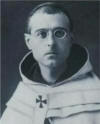 Padre Raffaello Rossi before becoming bishop and cardinal
Padre Raffaello Rossi before becoming bishop and cardinal
Levitation to leave the confessional
Answering a specific formal question by Mons. Raffaello Rossi,
Padre Pio confirmed that one day he left the confessional of men walking
over their heads: “The sacristy was overcrowded with men, it was hot; we were
suffocating. I saw that the best thing was to leave, so that they would leave
too. I remember that there was no room to walk: I had to step over those men;
then I found myself outside. From there I turned, and sent them away.”[31]
Levitation to reach the altar:
Brother Bill Martin, later Father Joseph Pius, from Brooklyn, New York, helped
Padre Pio last three years (1965-1968). He caught Padre Pio falling in his last
Mass.
He reported: "It was near the end
of Padre Pio's life. Another brother and I were helping him to the altar. He was
going to say Mass. I remember thinking 'Why his weight on my arm feels like
nothing at all." That's when I looked at the floor. Padre Pio's feet were six
inches off the ground. He was just gliding. He was levitating on his way to say
Mass. I exchanged a glance with the other monk. We had come to the same
realization at about the same time. We never spoke about it. We just knew."[32]

Padre Placido Bux
Padre Placido Bux, former classmate of Padre Pio, was dying in the hospital of
San Severo. One night he saw Padre Pio at his bedside encouraging him to have
patience. He then saw Padre Pio place his hand on the glass window and disappear
outside the window. In the morning he saw the imprint of a hand on the
windowpane. He told the story to all around him. The news spread and a lot of
staff and other people came to see the imprint. Padre Piergiuliano, superior of
the convent of San Severo, was called, and he reprimanded Padre Placido. Every
attempt was made with detergents to clean the window. Padre Alberto, superior of
San Giovanni Rotondo was called. He didn’t believe the story. Padre Placido told
him to ask directly Padre Pio, since he was his superior. Back in the convent
Padre Alberto approached Padre Pio, but before he could say a word Padre Pio
asked: “How is Padre Placido?” Padre Alberto told him the story of Padre Placido.
Padre Pio replied: “And you, do you doubt it?” Padre Placido recovered
completely from his illness.[33]
[34]
[35]
Through the door
Dr. Sala, Padre Pio’s physician, one evening was traversing the church square
when he saw Padre Pio making his way to the convent entrance. He said “Good
evening” but had no answer, and Padre Pio passed calmly through the unopened
door and disappeared. The day after: “Padre, I greeted you last night when you
walked in the square, but you didn’t answer.” “Oh! Evidently I didn’t hear you.”[36]
Bilocation
Bilocation is the simultaneous presence of same person in two different places.
Padre Pio describes the bilocating person, under obedience: "He knows what he
wants, knows where he goes, but he doesn't know if it's the body or the soul
that goes."[37]
[38]
[39]
[40]
[41]
[42]
"There is urgency, a grave danger, a soul or a body to save".[43]
[44]
Padre Pio after he received the wounds in 1918 never left San Giovanni Rotondo,
yet many people have seen him and spoken to him in places scattered all over the
globe; even today.
Padre Romolo
Padre Romolo da San Marco in Lamis testified on June 20, 1921: Padre Pio repeats
very often the words of the sacramental absolution, Especially the words
absolvo and
peccatis. We have heard him at an
open window, in sacristy, even during Mass. This might be related to bilocation.[45]
Mons. Rossi
Padre Pio questioned by Bishop Rossi, under oath, in 1921, about bilocation: “It
did happen to me to be in the presence of this or that person, in this or that
place. I do not know if my mind was transported there, or what I saw was some
sort of representation of the place or person. I do not know if I was there with
my body, or without it.”[46]
For example “One night I found myself at the bedside of a sick woman, Maria
Massa, in San Giovanni Rotondo. I was in the convent. I think I was praying. I
didn’t know her personally. She had been recommended to me. It must have been
over a year ago.”[47]
First known bilocation of Padre Pio
Padre Pio was 18, and studying philosophy in Sant'Elia a Pianisi, when he
experienced bilocation for the first time.
He had the presence of mind to write down his experience within three weeks and
consign it to his superiors.
[48]
He wrote on February 1905: "Few days ago an unusual thing happened to me. I was
in the choir with Fra’ Atanasio at about 11 PM on January 18, 1905, when I found
myself far away in Udine, were a father was dying and a child was being born."
The Virgin Mary told me: 'I'm entrusting this child to you. One day she will
come to you, but you will meet her first in Saint Peter’s.’ After that I found
myself back in the choir.”
[49]
[50]
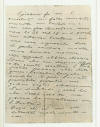 Page handwritten by future Padre Pio in February 1905
Page handwritten by future Padre Pio in February 1905
The girl to be born was Marchioness Giovanna Rizzani Boschi. Vanina for her
friends.[51]
She is one of 6 witnesses who testified at the Process of beatification. Her
life was full of coincidences that don't have a rational explanation. She was
born January 18, 1905.
Padre Pio handwritten note was kept for years by Padre Agostino. Later he gave
it to Giovanna. Giovanna asked Padre Pio about it and he confirmed the
authenticity.[52]
[53]
[54]
The dying person was Giovanni Battista Rizzani. His wife Leonilde had been
praying at his bedside, hoping for a last-minute conversion. Leonilde saw a
young Capuchin standing over the husband’s bed. As soon she looked at him he
left the room and disappeared down the corridor.
She was then caught by violent contraction and gave birth to a five weeks
premature girl.
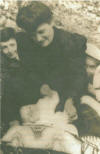 Newborn Giovanna Rizzani with her mother Leonilde
Newborn Giovanna Rizzani with her mother Leonilde
After the death of her husband, Leonilde moved with her daughter to Rome, to live with her parents.
 A confessional in St. Peter's basilica
A confessional in St. Peter's basilica
In the summer of 1922 Giovanna went with a friend for
confession in St. Peter’s basilica. When they arrived it was almost closing time
and they were told to come back next day. On the way out Giovanna saw a Capuchin
hurriedly enter a confessional. She immediately went to him and confessed. After
confession she and her friend waited for the Capuchin to get out, to greet him.
The custodian saw them and asked them to live. They told him about the Capuchin
in the confessional. The man looked in the confessional. It was empty.
In 1923 Giovanna heard about Padre Pio and went to see him with some friends.
He told her: “I know you. You were born the day your father died. I have been
waiting for you all these years.” She replied: “You are mistaking me for someone
else.” Padre Pio: “No. You already know me. Last year in St. Peter's I was the
capuchin priest who confessed you. Don’t you remember?"
She was very surprised and confused.
Padre Pio continued: "Giovanna, the Virgin Mary took me to Udine just before you
were born to be, and I witnessed your father's death. Our Lady informed me that
his wife was about to give birth to a girl and that she was placing this child
under my care. My daughter, you are my responsibility. One day you will be
present at my death."
Giovanna was perplexed and filled with emotion. She said: “Should I become a
nun?” Padre Pio: “No. Come frequently to San Giovanni Rotondo and I will guide
your soul.”
Many years later she heard the voice of Padre Pio: “Come soon to San Giovanni
Rotondo because I’m going away. Giovanna was now an elderly lady. She went
accompanied by her friend Margherita Hamilton four days before Padre Pio’s
death. She confessed to him, and he concluded: “I absolve you now of all the
sins you have ever committed. I am going away.”
The night of Padre Pio’s death she woke up suddenly and said to her friend
“Padre Pio is dead.” The both left the hotel room and went toward the convent in
the middle of the night. Already a small crowd had gathered in the square in
front of the church were a friar was announcing the death of Padre Pio.
Later she described the vision she had of Padre Pio's cell the night he died.
She reported every detail of what had happened, and described every person that
was in the room.[55]
[56]
[57]
[58]
[59]
[60]
[61]
On September 23, 1978 Padre Paolo Covino, who had administered the last rites to
Padre Pio, was on the square of the church of St. Mary of the Graces. A woman
asked him: “Are you Padre Paolo? I saw you in a vision, administering the last
rites to Padre Pio on September 23, 1968.” The lady was Giovanna Rizzani.[62]
Padre Vittore da Canosa
Padre Vittore da Canosa was dying in his cell in the Foggia convent. He told
Padre Rosario: “What a grace I received this evening! If I live I will write it
down; if not, I will tell you about it.” Those were his last words. He died
without being able to write or tell of the grace received. Padre Rosario later
told other friars about the episode. One of them, Padre Francesco, reported that
at the time of the death of Padre Vittore he was in San Giovanni Rotondo taking
care of Padre Pio. Padre Pio was ill, alone in his room. Padre Francesco heard
that Padre Pio was talking to somebody but he couldn’t understand anything. A
bit later he went to Padre Pio and told him that he had heard him talking while
nobody else was in his room. Padre Pio: “Yes. I was hearing someone’s
confession.”[63]
Coma
In 1918 Nina Campanile, one of the first spiritual daughters of Padre Pio, did
not know what bilocation is. Her sister had multiple severe internal injuries in
a fall, and fell in a coma. The doctors said that nothing could be done but wait
for her to die. Nina run to the friary and Padre Pio told her that her sister
would recover. Nina went back to her sister but she was still unresponsive. She
called, pinched, and tapped her to no avail. A friend of Nina’s was there in the
room and all of a sudden turned pale.
Nina asked her if she was getting sick. She replied: “Padre Pio is here.”
Nina: “What do you mean?” The friend: “Padre Pio has come near your sister, and
he said: “Poor child!” After ten minutes she said: “Now he has gone away.” Nina
was very puzzled. She was now looking at her sister, and saw her suddenly regain
consciousness and say: “I feel much better.” Nina looked at her watch. It was
8:00 PM. The morning after she went straight to the convent, and asked Padre Pio
point blank: “What time did you come to my house last night?” Without batting an
eye he said in a matter of fact way: “Around eight o clock.”[64]
[65]
Margherita was sharing a small flat with two other girls. She got up every
morning to go to Padre Pio’s Mass. She was waken up “by the alarm clock in the
hallway”. On day she told Padre Pio: “I saved some money and would like to by my
own alarm clock. What do you think?” Padre Pio: “Well, it’s about time!” She
bought the alarm clock and brought it home. She told the other girls: “Listen,
don’t worry anymore to set up the alarm for me in the morning. The girls: “What
are you talking about? There is no alarm clock in the house!”[66]
Convent in Pietrelcina
On December 13,1941 Padre Agostino asked Padre Pio: “Are you going to
Pietrelcina for the opening of the convent?” “I will be there in Pietrelcina,
and at the same time I will be in the confessional in San Giovanni Rotondo.”[67]
[68]
Alps
Padre Alessio entered Padre Pio’s room one night and found him shivering even
though it was a warm evening. He piled blankets upon him without result. Later
he learned that at that very hour, a man dying high in the Alps insisted that
Padre Pio was present with him.
[69]
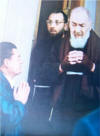 Desiderio Magnani
Desiderio Magnani
Desiderio Magnani
Desiderio Magnani of Padua in August 1962 was repairing the car in his garage,
lying in a cavity beneath it, when the car suddenly caught fire and caused very
severe burns, including his face. In the hospital the doctors gave little hope
of survival because of 60% of the body burned, high fever, kidney block and
heart failure. His sister sent a telegram to Padre Pio. The next day Desiderio
wakened as if from a deep sleep and told his sister that he had seen a friar
besides his bed, who blessed him. In a short while he was completely healed.[70]
Holy Family in Pietrelcina
In 1951 was consecrated the new church of the Holy Family in Pietrelcina. Padre
Alberto D’Apolito went to the ceremony from San Giovanni Rotondo. Upon his
return he told Padre Pio: “Someday you should go and see how beautiful the
church is!” Padre Pio: “I was there. I can describe to you the minutest details,
such as the number of steps to the entrance; and this is something that you
don’t know!”[71]
Padre Alberto later wrote: “In fact, I had never counted the steps.”[72]
Padre Benedetto
On July 18, 1942, Padre Benedetto, former spiritual director of Padre Pio, was
dying in the convent of San Severo. Padre Aurelio, the guardian, asked him if he
would like them to send for Padre Pio. Padre Benedetto replied: “No, there is no
need to send for him. He is here beside me.”[73]
[74]
Bilocation to assist a dying Franciscan tertiary
In the early days, Padre Nazareno went in town with Padre Pio to visit a
Franciscan tertiary gravely ill. The day after he reported to Padre Pio that she
had died during the night. Padre Pio said: “I know. I assisted her. She went
straight to Paradise.”
Bilocation to the Holy Office of Inquisition:
In 1970 Madre Speranza di Collevalenza (now Venerable) told journalist Renzo
Allegri: “At the Holy Office I saw Padre Pio every day for a whole year. He used
some half gloves on his hands to hide the wounds. I would greet him, kiss his
hand, and sometimes we exchanged some words. This took place between 1937 and
1939 when I was working at Sant'Uffizio (Holy Office).”[75]
Madre Speranza confirmed the story to Padre Alberto.[76]
[77]
Bilocation at a papal meeting:
The pope asked: "Who let that friar in?" The prelates run outside to upbraid the
guards for letting the friar in. All the guards strongly denied having seen any
friar. The Pope grew silent. Than he ordered Cardinal Silj to ascertain were
Padre Pio was that day and hour. Silj went to San Giovanni Rotondo with his
sister in law Countess Virginia Silj-Salviucci. Cardinal Silj asked the superior
of the convent, giving him details, were was Padre Pio at that certain date and
time. The superior gave him the details requested. Cardinal Silj reported to the
Pope that Padre Pio was in the choir of his friary, saying the Office. Pope Pius
XI never mentioned again of suspending Padre Pio from his priestly faculties.
This episode was reported by Countess
Virginia Silj-Salviucci to Padre Pio Dellepiane, and revealed only after the
Pope Pius XI’s death.
[78]
[79]
Bilocation to save a General
General Luigi Cadorna, Supreme Commander of Italian Army, after the defeat of
Caporetto, on November 12, 1917 was about to pull the trigger to shoot himself.
A friar appeared in front of him. "General, you will not do this stupidity!" He
didn’t.
After the war he recognized Padre Pio in a picture, and went to visit
unannounced.
Padre Pio from afar: "Yeah, general, we had a narrow escape that night!"[80]
[81]
(In 1917 Padre Pio was a soldier in the Italian Army, on sick leave).
Bilocation during a bombardment
Francesco Cavicchi and his wife visited Padre Pio in June 1967. He had confessed
three days before, but wanted to confess to Padre Pio anyway. The rule was at
least seven days. He stood in line and when his turn was approaching he got
agitated. But Padre Pio calling him from the line said: "Come forward, my son, I
have been waiting for you for a long time." He started the confession asking:
"How many days has it been since last confession?" Francesco said that he
couldn't remember. Padre Pio: "You have a short memory, don't you. But let me
ask you this. Do you remember the bombardment In Rimini many years back? Do you
remember the air raid shelter? Do you remember the trolley bus? But why I'm
asking you to go back in time? You cannot even remember what you did less than a
week ago!"
At that point Francesco started recollecting that in November 1943, when he was
28 years old, he was riding the trolley bus with about ten other people,
including a middle aged monk. Than the bombs started falling, Francesco had
difficulty getting off the bombed bus to reach the air-raid shelter and thought
he was about to die. The monk helped him. The capuchin monk once in the shelter
began to recite the rosary and inspired calm and confidence in everyone. After
the sirens gave the 'all clear" signal, the capuchin monk was the first to
leave. Suddenly Francesco: "Were you the monk?" "Well, who do you think it was?"
America
Padre Francesco Napolitano had just returned from New York and was describing to
the friars in the refectory what he had seen in America. Padre Pio was intent on
listening to him, and then said: “You have been there only once. I have been
hundreds of times.[82]
Padre Rosario da Aliminusa, superior of the convent for three years, wrote down
a diary of what was going on about Padre Pio. He wrote of a woman in America.
She had an incurable tumor, and she saw Padre Pio, who assured her that she
would be cured. She was cured and lived a normal life. Days after, Padre Eusebio
da Castelpetroso read the description and told Padre Pio: “So you took a trip to
America. I found out that you went to see a lady who had a tumor.” Padre Pio:
“How did you find out?” Padre Eusebio did not answer the question, but asked
Padre Pio how did he manage the language. Padre Pio: “How many miracles do you
expect the Lord to perform!”[83]
American spiritual child
Father would you take me for spiritual child? Yes. But next week I will be
living for America. "And you think that I can't reach you there and slap you if
you don't behave?”[84]
St. Vincent Hospital
Father Joseph Pius reported that in 1967 an American Lady turned up at the
convent. She had been lying in St. Vincent’s Hospital in New York, dying of
cancer. On day while she was praying she saw padre Pio appear at her bedside. He
smiled at her, blessed her, and then was gone. The woman recovered completely.[85]
Bilocation in the USA (Wisconsin):
On
June 25, 1950 Padre Pio was seen attending to the death of a fellow monk in
Milwaukee, Wisconsin, without leaving the convent. When asked about it he said:
"If Christ multiplied the loaves and
fishes, why cannot He multiply me?"
Padre Dominic Meyer’s father was dying in Wisconsin, while he was in San
Giovanni Rotondo helping Padre Pio.
The last time he has seen his father, he had made a request: “Son, you are Padre
Pio’s friend, you know him well, will you ask him to help me here when my time
comes?” The first time Padre Dominic was alone with Padre Pio, he explained,
apologized, and made the request. Padre Pio slowly nodded. The father was
staying in the house of a married daughter. On a beautiful afternoon, since he
couldn’t walk, the daughter and her husband helped him to sit on the porch. When
they went to bring him back to his room he was not on the porch. Not a step had
been heard, nor a door opening or closing. They hurried to his bedroom, and
there he was, lying in bed, eyes closed, and mouth slightly open. “And Dominic,”
said his sister, “we saw a Host on his tongue.”[86]
In 1973 Tony John Colette of Houston, Texas, after multiple surgeries, was dying
of a rare case of lipidosis. His case had been featured in the Medical Journal.
He and his relative had been praying Padre Pio. He was about to be discharge the
following day from St. Joseph Hospital. The doctors said there was nothing else
they could do for him. At 3:00 AM he saw Padre Pio. He told him: “I want to help
you. I will try to help you.” At the moment he felt a shivering from head to
toe. Padre Pio had disappeared and
he got up perfectly healed. Doctors, students, relatives, were amazed. Tony
said: “I feel profoundly privileged.”[87]
Andrea Bacile form San Martino in Pensilis was frequently rude with his wife and
children. One day that he was particularly misbehaved, he saw Padre Pio in front
of him. He had seen in him in pictures, but never in person. He was shocked. He
asked to confess. Padre Pio said “No”; and then disappeared. Andrea apologized
to his wife and children and started a pilgrimage on foot to San Giovanni
Rotondo. For three days he walked without resting or eating. When he reached the
convent he confessed to Padre Pio. After the absolution Padre Pio said: “Now go
eat something.”[88]
Bilocation in England
The evening of January 20th, 1936, Dr. Guglielmo Sanguinetti, was talking to
Padre Pio in his cell.
Suddenly Padre Pio took to his knees and urged them to pray “for a soul that is
soon to appear before the tribunal of God.” Afterwards Padre Pio said: “Do you
know for whom you prayed? It was for the King of England.” Around midnight padre
Pio went to the room of Padre Aurelio: "Let's pray for a soul which at this
moment is about to appear at the tribunal of God.”
The next day the newspapers announced the death of King George V.[89]
[90]
[91]
[92]
[93]
[94]
Alice Jones
In 1982, Alice Jones, a teacher, Episcopalian, had been bedridden for ten years
after multiple surgeries for a
neurofibroma paralyzing of the left side. One day re. Eric Fisher, a catholic
priest wen to pray with her. “The priest was kneeling at my bedside. Suddenly
was like another person came out of rev. Fisher. I was terrorized at the sight.
It had the face of an old man with a beard. He showed me his hands with a hole.
He put his hands on me. He said: ‘Get up and go.’ I did. I was crippled no
more.” Few days later I recognized the old man in a picture of Padre Pio.”[95]
Bilocation in Ireland
Christy Gallagher from Donegal, Ireland, was very ill in a hospital bed. He told
his wife: “Padre Pio came to see me; he asked me whether I would like to have
Communion. I did.” It was September 23, 1968. He was brimming with joy. Few
hours later he heard over the radio the announcement that Padre Pio had died.[96]
A man living alone in his apartment in Rome had planned to visit Padre Pio.
Lately there had been several burglaries in his neighborhood. There were no
alarm systems at the time. He was undecided if to go, and prayed Padre Pio: “I
will come, but you watch my house.” He went to padre Pio, confessed, then
decided to stay a little longer. The day after Padre Pio passing in the hallway
told him: “You are still here? I am working protecting your door.”[97]
 Padre Eusebio Notte talking to Padre Pio
Padre Eusebio Notte talking to Padre Pio
Padre Eusebio Notte plucked up courage to ask Padre Pio: “You know this man’s
house. Don’t you?” “How could I? I have not left the convent for so many years!”
“But he saw you!” “Ah! That’s a different story. When this things occur the Lord
only permits the person concerned to be seen, not the surroundings.”[98]
Concetta Bellarmini
In 1926 Concetta Bellarmini, while in critical condition, was suggested to pray
Padre Pio. She did not know Padre Pio but prayed for his intercession. Later, a
capuchin friar standing and smiling at her bedside said: “Sunday morning you
will be healed."
She did recover. Weeks later she went to thank Padre Pio. From afar she
exclaimed: 'That's him. That's exactly him."[99]
[100]
Maria Pompilio, a spiritual daughter living near the convent, testified that one
evening she was praying when she began to doze off. Someone slapped her on the
right cheek and the hand seemed the one of Padre Pio. The day after, she asked
Padre Pio if he had slapped her. Padre Pio: "That's what happens when you doze
off while you are praying."[101]
Maria Pompilio testified that a man seeing Padre Pio remove his vestments in the
sacristy after Mass, said: 'Yes, he is the one. I'm not mistaken.' Then,
kneeling and in tears said over and over: 'Padre, thank you for saving my life.'
Outside the church he told his story to Pompilio and other onlookers who had
been in the sacristy: 'I was captain in the infantry in the battlefield under
heavy fire. I saw a monk a short distance away who called me.' "Captain come
here by immediately." 'I did, and even before I reached him a grenade exploded
were I had been, leaving a hole in the ground. When I turned back the monk was
not there anymore.'[102]
Savino Greco
Savino Greco from Cerignola had a brain tumor and another tumor in the back of
his right eye. He went to a specialist in Bari, and the diagnosis was confirmed.
He was transferred to Milan for surgery. He had a dream of Padre Pio who told
him: “With time you will be cured.” When the time came to operate, he was so
scared that run away from the hospital. He went to stay with a cousin in Milan.
After few days the pain was so intense that he decided he had no choice but to
try surgery. Back in the hospital the surgeon did a pre operatory examination
with the other doctors. During the examination Savino smelled an intense perfume
of violets, roses, and lilies. When the doctors finished the examination they
were completely amazed. There was no trace of any tumor. They said he could go
home.[103]
 Maria Pompilio al left in the picture
Maria Pompilio al left in the picture
Bilocation at the Judgment:
Maria Pompilio wrote in her “Memorie di Padre Pio” that when her brother died,
she asked Padre Pio to intercede so that he could come in her dreams. Her
brother came in a dream and said: "Padre Pio assisted me in my agony. He stayed
until the Judge judged me. I was given eleven years of Purgatory, but for
intercession of Padre Pio the pain was reduced to one year. Many mysteries in
the life of Padre Pio will be known only in the other world." The morning after
Maria went to see Padre Pio. From afar he said: "Are you glad now?" "Yes, it
seems that you are everywhere." Padre Pio replied: "What sense has for me being
on Hearth if I can't go up and down. I know. Your brother told you that the
mystery of my life will be known only in Paradise."
Bilocation in France:
On January 29, 1957 in Alençon (France) Daniel Batonnier was about to die of
cerebrospinal meningitis. The
mother at 13:30 sent a telegram to Padre Pio. At 16:00 the child was fully
recovered. The doctors were puzzled. The child, seeing a picture of Padre Pio:
'Mom, I know that friar. He came to see me twice today. He was humming so as not
to scare me, and then he left. Mom when I grow up I want to be a friar like
him'.
 Padre Pio brings to Cardinal Mindszenty bread and
wine to celebrate mass. Mosaic in St. Pio's crypt.
Padre Pio brings to Cardinal Mindszenty bread and
wine to celebrate mass. Mosaic in St. Pio's crypt.
In 1956 Padre Pio served the Mass of
Cardinal Mindszenty while he was incarcerated in Budapest. The news spread.
Padre Pio was asked: "Did you really talk to him, did you really see him?
“Certainly, if I have talked to him, I must have seen him."
In another occasion: 'Did you visit
Cardinal Mindszenty while he was prisoner in Budapest in 1956?' "Yes. I have
seen him and spoken to him."
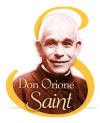 Saint Luigi Orione
Saint Luigi Orione
Bilocation to honor 2 fellow saints in Rome:
Saint Luigi Orione made this statement: "I saw Padre Pio in St. Peter's Basilica
the day that Saint Therese of the Child Jesus was declared blessed. He came
smiling towards me, walking through the crowds. He disappeared when we were few
feet away from each other." That happened on April 29, 1923.[104]
[105]
[106]
[107]
Napoli
Padre Bonaventura was preaching in 1956 in the basilica of the Holy Spirit in
Naples. Padre Pio appeared in the church for about forty minutes. Everybody in
the assembly saw him. Padre Bonaventura wrote to Padre Carmelo, superior at the
convent, about it. Padre Carmelo thought of a hallucination, and asked Padre
Pio: “Is Padre Bonaventura right?” Padre Pio answered: “Yes, it is true. It is
true.”[108]
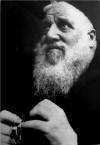 Padre Domenico da Cese Manoppello
Padre Domenico da Cese Manoppello
Bilocation last day of life
Padre Domenico Petracca da Cese Manoppello, a Capuchin friar who had been friend
with Padre Pio since 1940 reported
that early in the morning of September 22, 1968 he went to open the church at
Manoppello, located more than 200 kilometers away to the north of San Giovanni
Rotondo, in the province of Abruzzi. Inside the church he found Padre Pio on his
knees in the first row pew, his head in his hands, before the image known as the
Holy Face. Padre Pio said to him: “I do not trust myself any more. Pray for me.
Goodbye until we meet again in Paradise.”
Padre Pio died few hours later.
A woman went stay with the daughter and son in law in Bologna, while waiting to
have surgery for a malignant tumor in her arm. She was sitting alone in the
living room when a capuchin friar came through the door. "I am Padre Pio da
Pietralcina". He exhorted her to
have faith in the Madonna and blessed her arm. Then he said good bye and left.
The day after she met the doctor to go over the details of the surgical
intervention. The surgeon examined the arm. There was no trace of the tumor.
Last known bilocation when Padre Pio was alive:
Padre Umile, friend of Padre Pio was bedridden in Genova because of a fall. On
September 22, 1968 at 4:30 PM Sister Ludovica brought to Padre Umile a cup of
tea. In entering the room she felt and intense perfume of flowers. Padre Umile
said to her: "Padre Pio went to say me the last goodbye." Few hours later Padre
Pio died.[109]
Giacomo Cadice
On October 24, 1949 the newspaper Il Progresso Italo-Americano reported this
story. Giacomo Cadice had run away from home. In time the parents received a
letter form Sidi-Bel-Abess in Algeria, where he stated that he had joined the
Foreign Legion and would have to stay there for five years.
His father Pietro went to Padre Pio asking for help. Padre Pio said: “Go
and pray. By the third moon your son will return home!” Next part of the story
was told by the son himself. One night he was on guard at an advanced post, when
he saw a friar gesturing with the hand to follow him. They went across the
desert for days, than embarked on a ship for Marseille in France, and the friar
disappeared. From there Giacomo reached his home, joining his family. When
Pietro showed his son a picture of Padre Pio, he immediately recognized the
friar and started crying.[110]
[111]
[112]
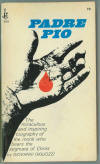 A book on Padre Pio by Giovanni Gigliozzi
A book on Padre Pio by Giovanni Gigliozzi
Giovanni Gigliozzi
Giovanni Gigliozzi was in a broadcasting studio in Rome, about to get on air
when he got a terrible blinding attack of migraine. He knew that it would last
for hours and he couldn’t do a thing about it. Suddenly he heard steps toward
him. He opened his eye and Padre Pio was there. He did not speak a word’ He just
gazed at him with an affectionate smile and laid his hand on his head, and
disappeared. So too did the migraine. Days later in the hallway of the convent
Padre Pio told him: “Well, Giovanni how is the head? Ah! These hallucinations!”[113]
Absolution
Padre Alberto reported that one afternoon on May 1928 he approached Padre Pio
who was standing at the window. He had the gaze fixed and was pronouncing the
words of absolution in a very clear voice. Padre Alberto called Padre Tommaso,
the superior, and both saw Padre Pio concluding the absolution. Few days later a
telegram came to Padre Tommaso from a city in northern Italy, thanking him for
having sent Padre Pio to assist a dying man.[114]
[115]
 Padre Carmelo da San Giovanni in Galdo showing a picture to
Padre Pio.
Padre Carmelo da San Giovanni in Galdo showing a picture to
Padre Pio.
Padre Carmelo da San Giovanni in Galdo, superior of the convent, decided to have meetings with the group
of early spiritual daughters, at the Ventrella's house, to gather firsthand
information about the beginning of Padre Pio's ministry in San Giovanni Rotondo.
The first meeting was held on December 14, 1954, on January 10 and 25, 1955, and
at later dates. Ten spiritual daughter were present: the Ventrella sisters, the
Pompilio sisters, Filomena Fini, Rosinella Gisolfi in Placentino,
Rachele Russo, Rachelina Gisolfi and Nina Campanile. Padre Carmelo testified:
'During the first meeting Rachelina Gisolfi told everybody that Padre Pio was
present. Back to the convent I didn't have the courage to ask Padre Pio about
it. During the second meeting Rachelina said again that Padre Pio was there.
Back to the convent I took the courage and asked him.
The answer: "Why? You don't want me there? You don't want that I come to those
meetings?"
After the third meeting, back to the convent: "Yes I was there." After another
meeting: "How come you don't ask me anymore if I came to the meeting?"[116]
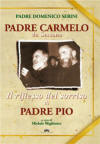 Padre Carmelo da Sessano with Padre Pio
Padre Carmelo da Sessano with Padre Pio
In 1953 Padre Pio was sitting with other monks for a play in the hall of the
friary. Padre Carmelo da Sessano, the Superior, was sitting by him. He reported that Padre Pio during the intermission "placed his arms on the back of the chair in front
of him and rested his head on them, remaining silent and motionless for few
minutes".
[117]
The next day, Padre Carmelo went to visit an invalid sick man in town and was
amazed when the man and his family expressed his appreciation for permitting
Padre Pio to go visit him the previous evening. Padre Carmelo asked about the
time and the duration of the visit. They matched perfectly with the
intermission.[118]
Ettore Masone, Padre Pio's only nephew. Was not yet thirty when he became
gravely ill, fell into a coma, and appeared dead. The family made arrangements
for the funeral next day. But all of a sudden he woke up and shouted: "I'm not
dying anymore." He recovered completely and instantly. He recalled: I was at the
gates of heaven and saw my sister Giuseppina who died many years ago standing
there at the door. Then I also saw Padre Pio. Both wouldn't let me in." That's
when he woke up.[119]
In 1952 a woman was about to die during delivery because of an erroneous blood
transfusion. She received the Last Rites. When the priest left she saw a monk.
"I am Padre Pio and you will not die. Say an 'Our Father' and one day you will
come to see me." About a year later she went to see Padre Pio. He told her: "You
got the miracle because the Sacred Heart sent me to save you, since you are
devout to him and did the First Fridays of each month."
The father of a capuchin friar from Maglie (Lecce) lay in bed, paralyzed with a
spinal disorder. The friar asked Padre Pio to pray for him. One afternoon the
sick man saw a bearded friar at his bedside. The friar gently told him: “Suffer,
suffer with patience”. The following day the same thing happened, and the man
was not improving. The afternoon visits continued. On the tenth day the visiting
friar said: “Enough is enough.” From then on the man started rapidly improving,
and after few days he was able to go back to farming. The farmer explained to
his capuchin son what had happened, and he recognized Padre Pio in a picture
shown to him.[120]
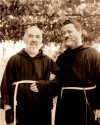 Padre Michelangelo with Padre Pio
Padre Michelangelo with Padre Pio
Extending length of life in bilocation:
Padre Michelangelo Bellini reported that his grandma was over eighty years old
and in a coma, when he prayed Padre Pio that she could live long enough to see
him celebrate his first Mass. By the morning she had made an extraordinary
recovery and told him that she had dreamed that a monk had brought her ten more
years of life. She lived exactly for ten more years.
The sister of Mons. Luigi D’Indico, the pastor of St. Joseph in the Santa Croce
neighborhood of Florence, Italy , was in a comatose state, suffering from
paratyphoid A and B. The family prayed Padre Pio. On July 20, 1921 at 2:30 PM,
Mons. D’Indico was working in his office. He felt that somebody was behind him.
He turned and saw a friar walking and leaving the room. He asked his secretary
who was that friar. The secretary thought that he was under stress because his
sister was close to death, and was having hallucinations. At the same hour Mons.
D’Indico’s sister saw Padre Pio at her bedside. He told her: “Do not worry,
tomorrow the fever will disappear, and in few days there will be no trace of the
illness in your body.” She got
rapidly better, and in few days was completely healed.[121]
[122]
[123]
[124]
A woman went to Padre Pio’s Mass, leaving her child at home. When she returned,
the daughter was eating a candy. The mom asked where she got the candy. The
child pointed at a picture of Padre Pio. Later, after the confession, Padre Pio
said: “Did you want a candy too?”
The only child of Antonio Massa, of San Giovanni Rotondo, was gravely ill and
parents and relatives took turns taking care of him. One evening he suddenly
started laughing and told his mom: “Mommy, Mommy, Padre Pio tickled my feet.” He
was recovered.[125]
Bilocation in the USA (Connecticut), perfume, handkerchief:
Joe Spada was hospitalized with terminal cancer in 1975. He, his wife, the
nurses and other people at the hospital were frequently overcome by the
beautiful aroma of fresh flowers.
One night he was alone and saw Padre Pio sitting beside him. When Margie
returned her eyes fell on a handkerchief that she did not recognize. As she
reached for it, Joe said, "That's Padre Pio's handkerchief. He put it there on
the stand just before he left." Still today on several occasions, Padre Pio's
handkerchief has given off the aroma of fresh flowers.
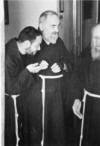 Fra Daniele kissing Padre Pio's hand
Fra Daniele kissing Padre Pio's hand
According to tradition in Loreto there is the house in which Mary lived. Several
times was reported that Padre Pio had been seen praying there in the evening.
One day Fra Daniele Natale took the courage to ask: “Padre, have you ever been
to Loreto?” “No.” “But people have seen you there!” “Oh! That is something
different.”
In 1937 Mons. Fernando Damiani, General Vicar of Salto, Uruguay, visiting Padre
Pio in San Giovanni Rotondo, had an hearth attack that lasted for two hours.
Padre Pio was called. He was confessing and went to see Mons. Damiani after the
acute phase had subsided. He told him: “I knew that you wouldn’t die, that’s why
I continued the confessions.”[128]
Damiani recovered and before returning to Uruguay he asked Padre Pio to be
helped in his final moments.
On September 1941 was held in Salto a Congress for Vocations, with the
intervention of several bishops, including Archbishop Antonio Maria Barbieri of
Montevideo. They were guests at the residence of Mons. Alfredo Viola, Bishop of
Salto. On the 11th of September, after midnight Mons. Damiani had
another hearth attack. Mons. Barbieri heard a knocking at the door. The door
opened, and a voice said: “Go help Mons. Damiani who is dying.” Mons. Barbieri
run to Mons. Damiani. Mons. Damiani asked for the last rites. Four bishops and
six priests were present for the extreme unction. A doctor visited the patient
and said there was nothing he could do. Mons. Damiani died peacefully about
thirty minutes after last rites. On the nightstand there was a draft of a
telegram written with shaking hands: “Padre Pio San Giovanni Rotondo –
Continuous chest pains are wiping me out.”[129]
[130]
[131]
[132]
[133]
[134]
[135]
[136]
[137]
[138]
Mons. Barbieri asked Padre Pio to assist him on his deathbed. Padre Pio:”I will
die before you will, but I’ll assist you from heaven”. Barbieri survived Padre
Pio by eleven years.[142]
In1958 Mons Viola gave to the friary a written sworn description on the events.[141]

Dr. Andrea Cardone made a written statement soon after Padre Pio’s death: “I,
the undersigned, Dr. Andrea Cardone, declare that I had a conversation with
Padre Pio on two occasions in my home in Pietrelcina. The first was on February
18, 1965, at 9:00 AM, the second of September 23, 1968, at 6:00 AM. On both
occasions Padre Pio was present in his mortal flesh, and our conversation lasted
several minutes.”[143]
Dr. Cardone was Padre Pio’s physician when he lived in Pietrelcina.
One young man in Rome was ashamed of his normal custom of tipping his hat when
passing in front of a Catholic church. He was scared that his friends would make
fun of him. But one time he heard Padre Pio’s voice in his ear saying: “Coward.”
Later on, he met Padre Pio in person and without saying anything Padre Pio said,
“Next time it will be a loudspeaker in the ear!”[144]
[145]
[146]
Agostino, d. S. (2012). Diario. San
Giovanni Rotondo: Edizioni Padre Pio. Ago12
Alberto, D'Apolito (2007). Padre Pio of
Pietrelcina. Memories. Experiences. Testimonials. San Giovanni Rotondo:
Edizioni Padre Pio. Alb07
Capobianco, C. P. (2006). Words and anecdots
of Padre Pio. San Giovanni Rotondo: Edizioni Padre Pio. Cap06
Capuano, P. (2012). Con p. Pio: come in una
fiaba. Foggia: Grafiche Grilli. Cap12
Castelli, F. (2011). Padre Pio under
investigation. The secret Vatican files. San Francisco: Ignatius Press.
Cas11
Cataneo, P. (1991). Padre Pio gleanings.
Editions Paulines Quebec. Cat91
Chiron, Y. (1999). Padre Pio. Una strada di
misericordia. Milano: Figlie di San Paolo. Chi99
Clarice Bruno (1970). Roads to Padre Pio.
Roma: Citta' Nuova. Bru70
Convento. (2001). Padre Pio dalla Terra al
Cielo. San Giovanni Rotondo: Edizioni Frati Cappuccini. Con01
Covino, P. P. (2007). Ricordi e
testimonianze. San Giovanni Rotondo: Edizioni Padre Pio. Cov07
Del Fante, A. (1950). Perla storia. Padre Pio
Il primo sacerdote sgigmatizzato. Bologna: Anonima Arti Grafiche. Del50
Duchess Suzanne, o. S. (1983). Magic of a
Mistic. Stories of Padre Pio. New York: Clarkson N. Potter. Duc83
Gallagher, J. (1995). Padre Pio, The pierced
priest. London: HarperCollins. Gal95
Gaudiose, D. M. (1974). Prophet of the
people. A biography of Padre Pio. New York: Alba House. Gau74
Iasenzeniro, F. M. (2006). The "Padre" saint
Pio of Pietrelcina. His mission to save souls. Testimonies. San Giovanni
Rotondo: Edizioni Padre Pio. Ias06
Ingoldsby, M. (1978). Padre Pio. His Life and
Mission. Dublin: Veritas Publications. Ing78
Malatesta, E. (1997). L'Ultimo segreto di
Padre Pio. Casale Monferrato: Edizioni Piemme. Malo97
McCaffery, J. (1978). Tales of Padre Pio.
Kansas City: Andrews and McMeel. McC78
Modestino, F. d. (2001). Io testimone del
Padre. San Giovanni Rotondo: Edizioni Padre Pio. Mod01
Morcaldi, C. (1997). LA MIA VITA VICINO A
PADRE PIO Diario intimo spirituale. Roma: Edizioni Dehoniane. Cle97
Mortimer Carty, f. C. (1973). Padre Pio the
stigmatist. TAN Books. Mor73
Napolitano, F. (1978). Padre Pio of
Pietrelcina. A brief biography. San Giovanni Rotondo: Edizioni Padre Pio.
Nap78
Padre, Raffaele (n.d.). Manuscript.Raf1
Pagnossin, G. (1978). Il Calvario di Padre
Pio. Padova. Pag78
Peroni, L. (2002). Padre Pio da Pietrelcina.
Borla. Perp02
Pietrelcina, P. P. (2011). Epistolario I
Corrispondenza con i direttori spirituali (1910-1922). San Giovanni Rotondo:
Edizioni Padre Pio. Epist. I
Pietrelcina, P. P. (2012). Epistolario IV,
corrispondenza con diverse categorie di persone. San Giovanni Rotondo:
Edizioni Padre Pio. Epist. IV
Rega, F. M. (2005). Padre Pio and America.
Rockford: TAN books. Reg05
Riese, Fernando da (2010). Padre Pio da
Pietrelcina crocifisso senza croce. San Giovanni Roronto: Edizioni Padre
Pio. Fer10
Ruffin, C. B. (1991). Padre Pio: the true
story. Huntington, Indiana: Our Sunday Visitor, Inc. Ruf91
Schug, J. O. (1987). A Padre Pio Profile.
Petersham, MA: St. Bede's Publications. Sch87
Stauffer, K. (2007). PADRE PIO An Intimate
Portrait of a Saint Through the Eyes of His Friends. Twenty Third
Publications. Sta07
Winowska, M. (1988). Il vero volto di Padre
Pio. Milano: Edizioni San Paolo. Win88
[1]
Raffaele manuscript
[2]
Cap12, 275
[3]
Con01, 166
[4]
Mod, 41
[5]
Cap12, 275
[6]
Cap12, 277-8
[7]
Ago12, 189
[8]
Cap12, 277
[9]
Mor97 45-6
[10]
Sch87, 92
[11]
Alb07, 109-11
[12]
Epist. I, 321
[13]
Ago12,29
[14]
Ago12, 53
[15]
Epist. I, 331
[16]
Cap06, 246-7
[17]
Cas11, 221
[18]
Ing78, 136
[19]
Duc83, 124
[20]
Mal97, 198
[21]
Mor97, 168
[22]
Mor73, 25-7
[23]
Reg05, 202-211
[24]
McC78, 31-2
[25]
Sch87, 80-4
[26]
Ruf91, 249-53
[27]
Cap12, 196-9
[28]
Cov07, 93-4
[29]
Mod01, 57-8
[30]
Cap06, 74-5
[31]
Cas11,220
[32]
Sta07, 4-6
[33]
Jng78, 91-2
[34]
Ruf91, 328
[35]
Alb07, 152-6
[36]
Bru70, 26
[37]
Ing78, 92
[38]
Bru70, 24
[39]
Gal95, 124
[40]
Gau74, 110
[41]
Pas50, 92-3
[42]
Cap06, 160-1
[43]
Win88, 102
[44]
Mor73, 55-78
[45]
Cas11, 187-8
[46]
Cas11, 208
[47]
Cas11, 208
[48]
Ruf91, 66
[49]
Epist. IV, 1027-9
[50]
Alb10, 315-6
[51]
Bru70, 105-110
[52]
Epist. IV, 1027
[53]
Alb10, 251-272
[54]
Cap12, 247-50
[55]
Ing78, 26-9
[56]
Sch87, 14-30
[57]
Ias06, 358-9
[58]
Gal95, 35-8
[59]
Chi99,39-40
[60]
Ruf91, 67-70
[61]
Alb07, 327-54
[62]
Cov07, 241-2
[63]
Cap06, 108-10
[64]
Ruf91, 144-5
[65]
Pag78, I, 42
[66]
Duc83, 127-8
[67]
Ago12, 168
[68]
Alb07, 129
[69]
Ruf91, 325
[70]
Ing78, 89-90
[71]
Ruf91, 326
[72]
Alb07, 129
[73]
Ing78, 57
[74]
Ruf91, 192
[75]
Sch87, 45-6
[76]
Sch87, 45-6
[77]
Alb07, 362-4
[78]
Per02, 325-6
[79]
Ruf91, 198
[80]
Win88, 100
[81]
Cap12, 250-1
[82]
Nap76, 183
[83]
Nap76, 183-4
[84]
Ale11, 142
[85]
Gal95, 125
[86]
McC78, 33-4
[87]
Fer10, 537
[88]
Cat91, 49-50
[89]
Gal95, 139
[90]
Mor73, 27
[91]
Ruf91, 241
[92]
Gau74, 118
[93]
Par011, 267-8
[94]
Cap06, 100
[95]
Fer10, 638
[96]
McC78, 34-6
[97]
Cat91, 69-70
[98]
Ing78, 92
[99]
Cat91, 136-7
[100]
Del50, 471-2
[101]
Cov07, 34
[102]
Ale10, 264-5
[103]
Gau74, 119-20
[104]
Win88, 103
[105]
Gal95, 124
[106]
Del62, 92-3
[107]
Nap76, 185
[108]
Sch87, 6
[109]
Ias06, 335
[110]
Cat91, 92-3
[111]
Del50, 160-3
[112]
Gau74, 111
[113]
McC78, 26-8
[114]
Sch87, 49
[115]
Alb07, 94-5
[116]
Ias06, 325
[117]
Ruf91, 325
[118]
Ruf91, 325
[119]
Ruf91, 271
[120]
Cat88, 100
[121]
Ruf91, 203
[122]
Del50, 474-5
[123]
Del62, 86-7
[124]
Pas50, 93-4
[125]
Cap06, 280-1
[126]
Cap12, 232-4
[127]
Gal95, 178-85
[128]
Ago12, 211 Note
[129]
Ago12, 212 Note
[130]
Win88, 100-1
[131]
Ale11, 207-211
[132]
Ale74, 604-7
[133]
McC78, 33-4
[134]
Ruf91, 243-5
[135]
Cap12, 251-21
[136]
Del60, 485-7
[137]
Gau74,110-1
[138]
Nap76, 185
[139]
Ago12, 210, Note 210-2
[140]
Cap06, 130-1
[141]
Ale10, 264-7
[142]
Ruf91, 245
[143]
Ing78, 90
[144]
Win149-50
[145]
Gau74, 162
[146]
Gau74, 163